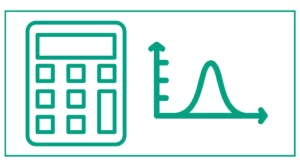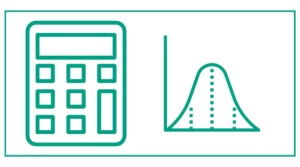5 Number Summary Calculator
The five number summary calculator helps you calculate the minimum, maximum, median, and first and third quartiles.
It also arranges the data in ascending order.
Enter the number separated by a comma or space to determine the 5 number summary.
The five-number summary provides descriptive statistics for a dataset.
A five-number summary shows the highest and lowest values, the lower and upper quartiles, and the median. This shows the most important things about a set of data.

You might want to calculate the grade curve or percentile rank.
What is a Five Number Summary?
A five number summary, also known as a five-point summary, is a set of descriptive statistics that provide a quick overview of the distribution of a dataset. As the name suggests, it consists of five key values:
- Minimum: The smallest value in the dataset
- First Quartile (Q1): The 25th percentile
- Median: The middle value (50th percentile)
- Third Quartile (Q3): The 75th percentile
- Maximum: The largest value in the dataset
These five numbers offer a comprehensive snapshot of your data, revealing important information about its central tendency, spread, and potential outliers.
The Importance of the Five Number Summary in Statistics
The five number summary is a fundamental concept in statistics, serving as a foundation for various analytical techniques and visualizations. Here’s why it’s so valuable:
- Data Distribution: It provides a quick overview of how your data is distributed, helping you identify patterns and trends.
- Outlier Detection: By comparing the minimum and maximum values to the quartiles, you can easily spot potential outliers in your dataset.
- Comparative Analysis: The five number summary allows for easy comparison between different datasets or groups within a dataset.
- Basis for Visualizations: It forms the basis for creating box plots (also known as box-and-whisker plots), which are powerful visual representations of data distribution.
- Robust Statistics: Unlike the mean, which can be heavily influenced by extreme values, the five number summary uses the median and quartiles, making it more resistant to outliers.
How to Calculate a Five Number Summary
While a five number summary calculator can quickly perform the calculations for you, understanding the process is crucial for interpreting the results. Let’s break down each component:
1. Minimum and Maximum
These are straightforward – simply identify the smallest and largest values in your dataset.
2. Median (Q2)
The median is the middle value when your data is arranged in ascending order. If you have an odd number of data points, it’s the middle number. For an even number of data points, take the average of the two middle numbers.
3. First Quartile (Q1) and Third Quartile (Q3)
To calculate Q1 and Q3:
- Divide the dataset into two halves at the median.
- Q1 is the median of the lower half.
- Q3 is the median of the upper half.
Using a Five Number Summary Calculator
While manual calculations are possible, using a five number summary calculator streamlines the process, especially for large datasets. Here’s how to use one effectively:
- Input Your Data: Enter your data points, typically separated by commas or spaces.
- Run the Calculation: Click the “Calculate” button to generate the five number summary.
- Interpret the Results: The calculator will display the minimum, Q1, median, Q3, and maximum values.
- Additional Information: Some calculators may provide extra statistics like the interquartile range (IQR) or a visual representation of the data.
Practical Examples of Five Number Summary Calculations
Let’s look at two examples to illustrate how a five number summary calculator works in practice:
Example 1: Small Dataset
Consider the following set of exam scores: 65, 70, 75, 80, 85, 90, 95
Using a five number summary calculator, we get:
- Minimum: 65
- Q1: 70
- Median: 80
- Q3: 90
- Maximum: 95
This summary tells us that the scores are evenly distributed, with a median of 80 and a range of 30 points from the lowest to the highest score.
Example 2: Larger Dataset with Outliers
Now, let’s look at a dataset of monthly sales figures: 1000, 1200, 1300, 1350, 1400, 1450, 1500, 1550, 1600, 1650, 1700, 5000
Using our calculator, we get:
- Minimum: 1000
- Q1: 1325
- Median: 1475
- Q3: 1625
- Maximum: 5000
In this case, the five number summary reveals an outlier. While most sales figures cluster between 1325 and 1625, there’s an unusually high value of 5000 that skews the distribution.
Interpreting Five Number Summary Results
Understanding how to interpret the results of a five number summary calculator is crucial for making informed decisions based on your data. Here are some key points to consider:
- Central Tendency: The median provides a measure of central tendency that’s resistant to outliers.
- Spread: The difference between Q1 and Q3 (the interquartile range or IQR) indicates the spread of the middle 50% of your data.
- Skewness: Compare the distances between Q1 and the median, and between the median and Q3. If they’re roughly equal, your data is likely symmetrically distributed.
- Outliers: Values far beyond Q1 – 1.5IQR or Q3 + 1.5IQR are typically considered outliers.
- Data Range: The difference between the minimum and maximum values gives you the overall range of your dataset.
Advanced Applications of the Five Number Summary
While the basic five number summary is incredibly useful, its applications extend beyond simple data description:
Box and Whisker Plots
The five number summary forms the basis of box and whisker plots, which provide a visual representation of your data’s distribution. These plots are excellent for comparing distributions across different groups or datasets.
Outlier Analysis
By using the IQR method (identifying values below Q1 – 1.5IQR or above Q3 + 1.5IQR), you can systematically detect outliers in your dataset.
Data Cleaning
The five number summary can help identify potential errors in data entry. Unusual minimum or maximum values might indicate mistakes that need correction.
Quick Comparisons
When dealing with multiple datasets, comparing their five number summaries can quickly reveal differences in central tendency, spread, and overall distribution.
Limitations of the Five Number Summary
While the five number summary is a powerful tool, it’s important to be aware of its limitations:
- Loss of Detail: By condensing the data into five numbers, you lose information about the specific distribution between these points.
- Assumption of Continuity: The five number summary assumes your data is continuous. It may not be as informative for categorical or heavily skewed data.
- Sample Size Sensitivity: For very small datasets, the five number summary may not provide a reliable representation of the underlying population.
- Multimodal Distributions: If your data has multiple modes, the five number summary may not capture this complexity.

References
- 2.2.10 – Five Number Summary | STAT 200. (n.d.). PennState: Statistics Online Courses. online.stat.psu.edu/stat200/lesson/2/2.2/2.2.10
- Čižmešija, M. (2011). Five-Number Summaries. International Encyclopedia of Statistical Science, 526–527. doi.org/10.1007/978-3-642-04898-2_255





